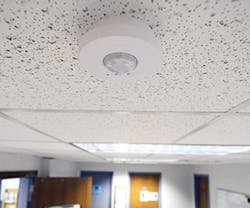Occupancy Sensors Conserve 1 Million Kwh Annually
At the Niagara Falls Air Reserve Station, energy efficiency is considered a mission critical strategy.
Working from a 2003 baseline, the military installation was tasked to reduce its energy use by 3% each year under the Energy Independence and Security Act of 2007. One of its latest projects to offset consumption was to install over 2,700 occupancy sensors at the end of 2013.
“We used a combination of wired, in-wall, and wireless ceiling-mounted occupancy sensors to control over 350,000 square feet, amounting to 1.8 million watts of connected power,” says Maj. Matt Heinsler, base energy manager.
Occupancy sensors were identified in a recent audit as an opportunity to achieve a high ROI. Interior lighting had already been switched to T8s and most exterior and high bay fixtures were slated for LED replacements – lighting controls were the next strategy that was easily in reach.
“Some of the highest areas of impact have been in restrooms, break rooms, fitness areas, conference rooms, storage closets, and hallways where lights were previously on 12 to 13 hours a day despite low levels of occupancy,” Heinsler notes.
Wireless sensors also saved on installation costs, providing the ability to expand occupancy controls without additional wiring.
“The bottom line is that occupancy sensors have saved nearly a million kWh annually, which translates to a cost savings of $84,270,” says Heinsler. “This will pay for the installation in three to four years, which means that everything we save for the next seven years can be put to better use. That’s a reinvestment opportunity of over $75,000 each year.”
For more real-world lighting projects:
Warehouse Visibility Boosted by Integrated LEDs
Monsanto Production Facility | Grinnell, Iowa
Retail Parking Lights Save $10,000 Annually
280 Metro Center | Colma, California
Area LEDs Create Secure Parking for employees
Aflac Support Center | Columbus, Georgia
College Auditorium Reduces Lighting Demands by 80%
Haywood Community College | Clyde, North Carolina
